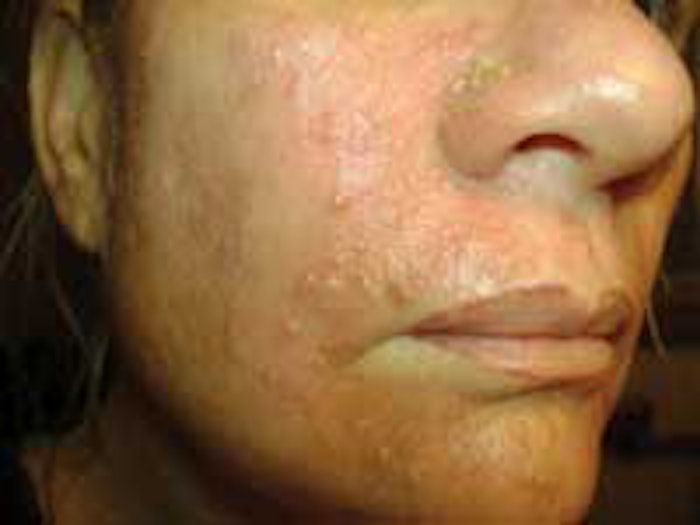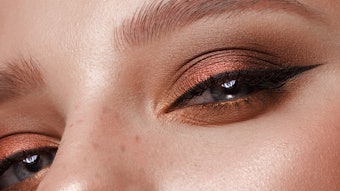
salicylic acid after microdermabrasion.
My patient left me a voice mail and her voice sounded concerned. “Dr. Carl,” she said. “I think something is wrong. I had a chemical peel three days ago, but instead of my skin being a reddish color with flakiness, I have lots of small pimples and it feels very itchy. Could you please call me?”
Sometimes unplanned reactions can occur in a medical spa or esthetic medicine practice. A spa professional must know how to handle unwanted, adverse reactions in a systematic way, but diagnosis must be determined by a medical professional.
It starts with prevention
Make sure you have recommended the right products for your client. It sounds fairly simple, but let’s review the basics. During the first appointment, thoroughly complete a consultation form and medical history. This helps to clearly identify the client’s concerns, allergies, medical history and current medications. Whenever possible, carefully analyze your client’s freshly cleansed skin with good lighting and a magnifying glass or loupe to identify areas of concern. A Wood’s lamp may also be added to identify ultraviolet (UV) damage that isn’t visible with regular light.
Go beyond your client’s skin type. There might be a difference in what she thinks her skin type is and what it actually is. Start with a treatment plan that fits your client’s needs, and then follow up. Call within three to five days of starting a new regimen and again at 14 days to check her progress, answer any questions and review instructions. Are any adjustments necessary to the existing regimen? What can be disconcerting is that sometimes clients who experiences negative responses or adverse reactions to products you recommend or procedures you perform won’t tell you. Either you never see them again, or they just don’t come back to purchase recommended products. A spa professional wants clients to have the best results and experience, so close follow-up is essential. Moreover, it is documented that the chance of being sued if a bad result occurs decreases when the professional is frequently communicating to try to solve the problem, referring to a dermatologist when necessary.
Don your detective hat
If your client experiences unusual reactions to the products you have recommended or to a procedure you performed, become an investigator to find out as many details as youcan to confidently solve the problem. The No. 1goal is to prevent permanent abnormalities, such as scarring or stretch marks. One of the most common causes of scarring is a secondary infection, usually to bacteria but also yeast, and viruses such as herpes simplex. Another common cause is performing a procedure or applying a chemical peeling agent that is too aggressive.
Unusual reactions can include the following.
- A red or purple, scaly or crusty rash that develops after product use—especially if areas where product was not applied are affected. The latter indicates the reaction is severe and usually requires prolonged prescription therapy.
- Clear blistering, especially if it is painful, strongly suggests herpes simplex, staphylococcal bullous impetigo or severe allergic reaction; this is a medical emergency and requires a dermatologist’s assistance for prescription treatment.
- If skin has become extremely sensitive, tender and photosensitive after product use, this could be an indication of contact allergy or irritant reaction.
- Cystic acne breakouts and/or furuncles occur that may result in scars. Prescription antibiotics and red light LED are very helpful, as well as an ice cube application and an acne heating device for directly heating the lesion. Prescription steroids also help to speed clearing.
- Swelling and hives with itching or stinging indicate an allergy, so a topical anti-inflammatory or over-the-counter (OTC) oral antihistamine may be needed.
- Pustules, deep scabbing, crusting or weeping usually indicate an infection. To determine the cause, cultures for bacteria, virus and yeast must be performed. Refer the client to a physician if the condition persists for more than 48 hours, is moderate to severe or has a painful reaction. Begin cleansing with an OTC antiseptic antimicrobial skin cleanser, then apply ice packs or ice water compresses for 10–30 minutes. Next, use OTC clotrimizole or miconazole cream, followed by an antibiotic ointment three times daily.
- Systemic reactions such as headache, dizziness or fever indicate more severe reactions, so notify a physician as soon as possible.
For destructive procedures such as chemical peels or dermaplaning, determine the following.
- What was the pre-care regimen?
- What was the exact protocol followed? Was a spot test conducted before the peel?
- What was the application method—textured gauze, cotton swabs/balls, cotton pads or a brush?
- Which chemical peeling compound was used, and what was its concentration (percentage/pH)?
- How much peel solution was used; how many layers were applied?
- How long was the peel solution left on before neutralizing?
- Did hot spots of bright white or blisters occur, or could the client detect certain areas that were excessively painful or tender during the procedure?
- What was the immediate post-care regimen?
Encourage your client to see you in person in order to actually view the reaction that is taking place. Try to take a picture to document the client’s response and subsequent healing process. If the client cannot come in person, sometimes using a cell phone with camera capabilities to send you a quick photo via e-mail is a good solution.
How to test for an allergy
Allergies to a specific ingredient can happen at any time, even when an client has been using the same formula for years. Many herbal ingredients will cross-react with others. For example, tea tree oil—one of the most common allergens—cross-reacts with lavender. Patch testing can be done by a spa professional, and you can test a product by applying it twice daily to the inner upper arm or thin skin in front of the elbow for up to two weeks. A reaction with itching in four days’ time indicates contact allergy, especially if a hive or blister occurs. Redness and tenderness on day five or later usually means it is a contact irritation.
Contact irritation occurs when an excessive chemical concentration or amount is applied. The procedure can be used again, but at no higher than 30% of what was previously used. All notes, treatments and products in use must be documented. Once all the details have been gathered, the answer may become clear.
For instance, the client may have inadvertently forgotten to disclose a specific product or prescription that she has been using, or did not discontinue a topical prescription, such as tretinoin, soon enough before a treatment. Other times, undisclosed previous treatments could affect the outcome of your procedures or, you may discover through asking questions that your client did not follow your recommended post-care instructions.
Many times, a simple regimen adjustment is all that is needed for your client. When a client begins a new regimen, those who have a more sensitive skin type, especially during a dry winter, may find it easier to start their new products slowly. Begin with one new product, and then add another every three to five days until you are confident there will be no negative reactions. This method also helps narrow down the product that causes the adverse reaction if one occurs. A trusted referral relationship with a dermatologist is important for any spa professional so immediate help can be obtained if necessary.
Have a plan in place
The client who left me the voice mail came to see me in person, so that I could visually assess her skin reaction. She had a history of sensitive, atopic skin, and the peel had created a secondary infection due to the high bacterial counts in her skin. Luckily, the secondary infection was able to be healed pretty quickly, and she cleared nicely without scarring with the regimen described above.
As a spa professional, your clients trust you to recommend products that are not only effective, but also safe. Offering home care products that have safety testing data, such as a human repeat insult patch test (HRIPT), is ideal to ensure products have a minimal risk of irritation or allergy (< 3/1000), or less than three adverse reactions per 1,000 test applications. Before retailing any product line, it is crucial to research the line and ask for safety testing data first to lessen the risk of adverse reactions. Of course, there are always rare exceptions, so be prepared. Having a plan in place when unforeseen reactions do occur is the best way to handle unusual situations.
Carl Thornfeldt, MD, is the founder and chief executive officer of Episciences, Inc., the manufacturers of Epionce skin care. He has practiced dermatology for 30 years and is co-author of the book, The New Ideal in Skin Health: Separating Fact from Fiction (Allured Business Media, 2010).










